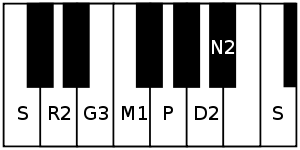Khamas (raga)
| Carnatic music |
|---|
Tanjavur-style Tambura |
| Concepts |
| Compositions |
| Instruments |
|
Khamas[1][2] or Kamas (pronounced kamās) is a rāgam in Carnatic music (musical scale of South Indian classical music). It is a janya rāgam (derived scale) from the 28th melakarta scale Harikambhoji. It is a janya scale, as it does not have all the seven swaras (musical notes) in the ascending scale.
It is a scale that evokes Shringara rasa.[1][2] It is suitable for javali type compositions.[2]
Structure and Lakshana

Khamas is an asymmetric rāgam that does not contain rishabham in the ascending scale. It is a vakra-shadava-sampurna rāgam (vakra-shadava, meaning 6 notes in ascending scale with zig-zag moves).[1][2] Its ārohaṇa-avarohaṇa structure (ascending and descending scale) is as follows:
The notes used in this scale are shadjam, antara gandharam, shuddha madhyamam, panchamam, chathusruthi dhaivatam and kaisiki nishadham in ascending scale, with chathusruthi rishabham included in descending scale. For the details of the notations and terms, see swaras in Carnatic music.
Alternate versions
Originally, Khamas was an upanga raga (uses only the notes in the parent scale). Later with the usage in javalis and other later compositions, the bhashanga type of Khamas came into use (using notes external to the scale).[1] Kakali nishadam (N3) is introduced as anya swara (external note) occasionally.[1]
According to Muthuswami Dikshitar school of music, Khamas is a sampurna raga with no zig-zag notes (no vakra usage).[1][2]
Khamaj of Hindustani Music closely resembles Khamas raga. The Hindi film song ‘Tere Mere Milan Ki’ from the movie Abhimaan is based on Khamaj.[3]
Popular compositions
There are many compositions set to Khamas rāgam. Here are some popular kritis composed in this ragam.
- Sujana jeevana and Seethapathe composed by Tyagaraja
- Entaninne by Subbarama Dikshitar
- Broche varevaru ra and Inda parakelanayya by Mysore Vasudevachar
- Idathu padam thookki by Papanasam Sivan
- Thillana by Patnam Subramania Iyer
References
- 1 2 3 4 5 6 Ragas in Carnatic music by Dr. S. Bhagyalekshmy, Pub. 1990, CBH Publications
- 1 2 3 4 5 Raganidhi by P. Subba Rao, Pub. 1964, The Music Academy of Madras
- ↑ Hindustani music's equivalent of Khamas Raga